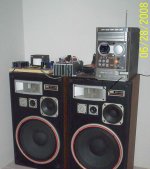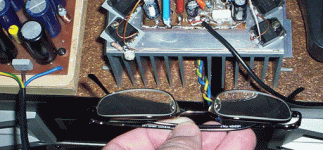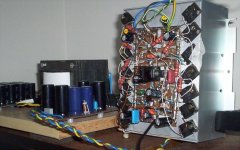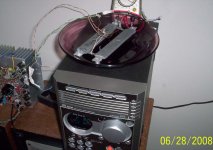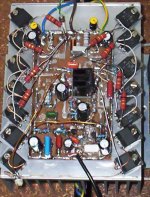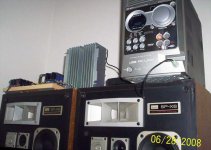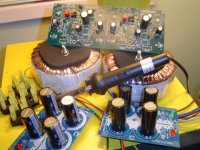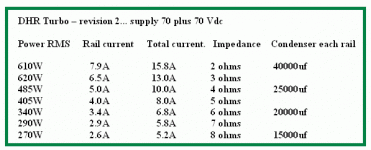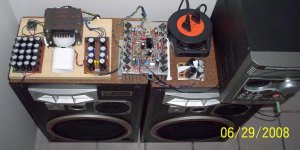We're holding on Carlos, we're watching in wonder as you fine tune your creation...keep up the progress reports, they're great to see.
best wishes,
brian
best wishes,
brian
Will keep you informed.... my pleasure...thank you by the kind support
I have to make this one a very huge amplifier....
Brazilians will not buy enormous heatsink...so..they will operate hot.
Brazilians will not use all the transistors i am asking them to use..so i have to put a little bit more than the needed ones.
Working hot, i have the need of optimized thermical sensor..reason why using 4 junctions, all them to sense the heat and reduce the bias.
So..... i am working with those ideas in mind.... have to make it hard to destroy...very huge...and have to test it full power into 1 ohms.... and reactive and inductive loads... and clip it.... using bad condensers in value.... have to put it to work under the worst conditions possible.
You can see the heatsink...small as a toy for this power amplifier.. undersized.... and operating into the wrong position to convection cooling.
If survive.... them will be good enougth
regards,
Carlos
I have to make this one a very huge amplifier....
Brazilians will not buy enormous heatsink...so..they will operate hot.
Brazilians will not use all the transistors i am asking them to use..so i have to put a little bit more than the needed ones.
Working hot, i have the need of optimized thermical sensor..reason why using 4 junctions, all them to sense the heat and reduce the bias.
So..... i am working with those ideas in mind.... have to make it hard to destroy...very huge...and have to test it full power into 1 ohms.... and reactive and inductive loads... and clip it.... using bad condensers in value.... have to put it to work under the worst conditions possible.
You can see the heatsink...small as a toy for this power amplifier.. undersized.... and operating into the wrong position to convection cooling.
If survive.... them will be good enougth
regards,
Carlos
Attachments
The heatsink i am using is not good enougth
It is good for 160 watts RMS amplifier, and this ones multiply that by 2 and to 3 depending the supply power and voltage.
This heatsink can dissipate around 220 watts ... it measures 15 by 15 (base) and has 12 fins, each one of those fins measure 15 by 8 centimeters.
I found the bias control is working fine... do not let the stand by current increase.... very hot and cold, the diference was lower than 30 percent.
Now i will tweak to obtain better voices.... sounds great, treble (hit hat) is wonderfull, also strings and bell sounds...deep bass is huge and impressive....excelent.... has some loss of control that remembers the Dx Standard.... some mix between Dx Standard and HRII...but i have not the Precision 1 voices... will tweak.
Bias is adjusted very low.... 500 microamperes to each power transistor...to help stability when the heatsink is not good..... of course, this same heatsink used double (I have two), one to PNP and other to NPN will work fine to average power.
regards,
Carlos
It is good for 160 watts RMS amplifier, and this ones multiply that by 2 and to 3 depending the supply power and voltage.
This heatsink can dissipate around 220 watts ... it measures 15 by 15 (base) and has 12 fins, each one of those fins measure 15 by 8 centimeters.
I found the bias control is working fine... do not let the stand by current increase.... very hot and cold, the diference was lower than 30 percent.
Now i will tweak to obtain better voices.... sounds great, treble (hit hat) is wonderfull, also strings and bell sounds...deep bass is huge and impressive....excelent.... has some loss of control that remembers the Dx Standard.... some mix between Dx Standard and HRII...but i have not the Precision 1 voices... will tweak.
Bias is adjusted very low.... 500 microamperes to each power transistor...to help stability when the heatsink is not good..... of course, this same heatsink used double (I have two), one to PNP and other to NPN will work fine to average power.
regards,
Carlos
Attachments
I have tried dummy loads, but smells a lot
I have adjusted to 250 watts RMS...dummy load to 3.5 ohms, as i was using two units of 7 ohms and 70 watts.... so.... 3.5 ohms and 140 watts continuous......hehehehe... started to smell and i have removed, but was helpfull to see how the thermal control was going.
Using electric shower resistance, full power distorted, i felt the amplifier could burn...heatsink too much small to its power.
This amplifier needs huge heatsinks...and giant speakers too.
hehehe
Carlos
I have adjusted to 250 watts RMS...dummy load to 3.5 ohms, as i was using two units of 7 ohms and 70 watts.... so.... 3.5 ohms and 140 watts continuous......hehehehe... started to smell and i have removed, but was helpfull to see how the thermal control was going.
Using electric shower resistance, full power distorted, i felt the amplifier could burn...heatsink too much small to its power.
This amplifier needs huge heatsinks...and giant speakers too.
hehehe
Carlos
Attachments
Zier Gut her Juergen!
I am using the dummy loads connected this way.
The amplifier see 3.5 ohms.... resistive and also inductive...not so different from 4 ohms speakers.... a small sample of the output voltage, already loaded by 3.5 ohms (two 7 ohms in paralel) crosses the series resistance and goes to my speaker...this way i can listen if clips or not.
Left arrows goes to amplifier power output... rigth side you see a speaker monitoring the sound quality.
regards,
Carlos
I am using the dummy loads connected this way.
The amplifier see 3.5 ohms.... resistive and also inductive...not so different from 4 ohms speakers.... a small sample of the output voltage, already loaded by 3.5 ohms (two 7 ohms in paralel) crosses the series resistance and goes to my speaker...this way i can listen if clips or not.
Left arrows goes to amplifier power output... rigth side you see a speaker monitoring the sound quality.
regards,
Carlos
Attachments
Hi Carlos🙂
Where are all the waveform pictures? They give all of us who cannot hear your amp from 1000's of miles....er...kilometers away a glimps of it's inner beauty.🙂
Where are all the waveform pictures? They give all of us who cannot hear your amp from 1000's of miles....er...kilometers away a glimps of it's inner beauty.🙂
No waveforms provided.. i have not a decent Scope here
Only computer simulator... and this one always give very nice waveforms..ahahahahah!
Analisis are fine too...but the simulator is not interested to assemble my amplifier..also simulator cannot listen...so... i am not very interested related "what the simulator thinks about my amplifier"... i want humans building and listening.
This is the real thing... simulators are a lovely tool....but it is just a tool.
If i had the scope in my home i would never have learned how to evaluate listening.... would prefer to search for beautifull wave shapes..unfortunatelly beautifull wave shapes do not means beautifull sound always...just sometimes.
I use to tune the amplifier listening.... and you know that a long time CBS.
regards,
Carlos
Only computer simulator... and this one always give very nice waveforms..ahahahahah!
Analisis are fine too...but the simulator is not interested to assemble my amplifier..also simulator cannot listen...so... i am not very interested related "what the simulator thinks about my amplifier"... i want humans building and listening.
This is the real thing... simulators are a lovely tool....but it is just a tool.
If i had the scope in my home i would never have learned how to evaluate listening.... would prefer to search for beautifull wave shapes..unfortunatelly beautifull wave shapes do not means beautifull sound always...just sometimes.
I use to tune the amplifier listening.... and you know that a long time CBS.
regards,
Carlos
Almost ready...tomorrow last listening tests with some modifications
The simulator data is here...of course, this do not take into account the supply voltage drop.
This was made, using simulator, and voltage was keept stable into 70 volts...of course real life is not this way.
But those informs are good reference:
DHR Turbo – revision 2... supply 70 plus 70 Vdc
Power RMS Rail current Total current. Impedance
610W 7.9A 15.8A 2 ohms
620W 6.5A 13.0A 3 ohms
485W 5.0A 10.0A 4 ohms
405W 4.0A 8.0A 5 ohms
340W 3.4A 6.8A 6 ohms
290W 2.9A 5.8A 7 ohms
270W 2.6A 5.2A 8 ohms
Input signal sinusoidal into 1Khz… continuous power into
The threshold of clipping.
regards,
Carlos
The simulator data is here...of course, this do not take into account the supply voltage drop.
This was made, using simulator, and voltage was keept stable into 70 volts...of course real life is not this way.
But those informs are good reference:
DHR Turbo – revision 2... supply 70 plus 70 Vdc
Power RMS Rail current Total current. Impedance
610W 7.9A 15.8A 2 ohms
620W 6.5A 13.0A 3 ohms
485W 5.0A 10.0A 4 ohms
405W 4.0A 8.0A 5 ohms
340W 3.4A 6.8A 6 ohms
290W 2.9A 5.8A 7 ohms
270W 2.6A 5.2A 8 ohms
Input signal sinusoidal into 1Khz… continuous power into
The threshold of clipping.
regards,
Carlos
You may put a high output tone(sine) pulse rather than continous sinewave through it to see at what point it clips, for various load 8, 4, 2, ohms.
That way you don't have to use high wattage load.
That way you don't have to use high wattage load.
Of course was made the way you told.
Sorry by the confusion, my english usually is not very clear.... or you do not know me.
Frequency is fixed into 1 Kilohertz
Volume, amplitude, audio AC voltage into the amplifier input is variable, adjusted, increasing, till the amplifier start to show clipping, then voltage is sligtly reduced not to have clipping into the waveform.
Then RMS output voltage is readed (voltage developed over the load) and multiplied by it's same value (squared) and then divided by the load impedance.... resulting RMS power output over some load impedance.
Signal is sinusoidal because it is standard, 1 kilohertz because standard too.
This is the method used since the dawn of audio electronic development, down the beginning of last century... the first 3 decades had the development of some methods of measurement that are still beeing use after some modifications.
Then appeared Institute of High Fidelity rules with pulse style peak readings (that crazy high level burst of audio, only one channel loaded, distortion was not measured.. full distorting power..heheheh)... now developed to the method we are using now a days.
Maybe you can inform me the document number about those measurements.... if you know the number, go ahead with the information.
regards,
Carlos
Sorry by the confusion, my english usually is not very clear.... or you do not know me.
Frequency is fixed into 1 Kilohertz
Volume, amplitude, audio AC voltage into the amplifier input is variable, adjusted, increasing, till the amplifier start to show clipping, then voltage is sligtly reduced not to have clipping into the waveform.
Then RMS output voltage is readed (voltage developed over the load) and multiplied by it's same value (squared) and then divided by the load impedance.... resulting RMS power output over some load impedance.
Signal is sinusoidal because it is standard, 1 kilohertz because standard too.
This is the method used since the dawn of audio electronic development, down the beginning of last century... the first 3 decades had the development of some methods of measurement that are still beeing use after some modifications.
Then appeared Institute of High Fidelity rules with pulse style peak readings (that crazy high level burst of audio, only one channel loaded, distortion was not measured.. full distorting power..heheheh)... now developed to the method we are using now a days.
Maybe you can inform me the document number about those measurements.... if you know the number, go ahead with the information.
regards,
Carlos
A busy bee! Great to see your efforts. It is hard work! Hard work counts for something! Tested with your ears you say! Excellent! Good choice of sensorium! I read about a speaker builder who tested one with his eyes,(numbers he measured) and said, "Don't ask me, I didn't listen to it". Ahahaha!!!
Life is mysterious Carlos. A lot of disagreement about stuff, well, just about anything if you talk to someone. Music. Even more horrible! Polemics, diatribes, parallel confusions. Gwen Stafani Queen, Gwen Stafani phooooey! Go figure. But from Eskimos to tribsman in the outback, the GIFT of music--everyone agrees its great! Voices and instruments coming out of a box! Who would have thunk it!!!More!!!Louder!!!More Brahams Symphonies!!!
Looking at your circuit board constructions fills me with awe. I wish i could draw solder lines and construct circuits like you do. Your fearless experimentation and quest to grasp the Holy Grail of the Gift of Music! I applaud. I give you a standing ovation! Emotion overcomes me!!! I weep!!!!!!!
ARRRRGGGG. I gird my loins! I'm gonna be a constructor! Just that! Do stuff! Talk smalk!
Parts are hard for me to get, and each wrong part ordered, or stuff I forget equals another week to wait for the parts to arrive...
I've got parts aplenty coming this week!
The HRII is gonna sing, see? Yah, and the DHR, it's gonna sing too, see? Yah! I'm a gonna put Astor Piazzolla Zero Tango Hour on first, see? I'll follow up with the Melvins and Shostokovich Symphony #1 after that! Ahhahaha!
Keep on, keeping on! Ahahaha!!
Gotta bend heatsinks and fill the rest of the Hrii boards next couple of days. (picture attached). I'll work hard! It counts for something, Carlos! I believe it counts!
Thanks for being a wonderful inspiration to so many.
Best wishes,
Brian
Life is mysterious Carlos. A lot of disagreement about stuff, well, just about anything if you talk to someone. Music. Even more horrible! Polemics, diatribes, parallel confusions. Gwen Stafani Queen, Gwen Stafani phooooey! Go figure. But from Eskimos to tribsman in the outback, the GIFT of music--everyone agrees its great! Voices and instruments coming out of a box! Who would have thunk it!!!More!!!Louder!!!More Brahams Symphonies!!!
Looking at your circuit board constructions fills me with awe. I wish i could draw solder lines and construct circuits like you do. Your fearless experimentation and quest to grasp the Holy Grail of the Gift of Music! I applaud. I give you a standing ovation! Emotion overcomes me!!! I weep!!!!!!!
ARRRRGGGG. I gird my loins! I'm gonna be a constructor! Just that! Do stuff! Talk smalk!
Parts are hard for me to get, and each wrong part ordered, or stuff I forget equals another week to wait for the parts to arrive...
I've got parts aplenty coming this week!
The HRII is gonna sing, see? Yah, and the DHR, it's gonna sing too, see? Yah! I'm a gonna put Astor Piazzolla Zero Tango Hour on first, see? I'll follow up with the Melvins and Shostokovich Symphony #1 after that! Ahhahaha!
Keep on, keeping on! Ahahaha!!
Gotta bend heatsinks and fill the rest of the Hrii boards next couple of days. (picture attached). I'll work hard! It counts for something, Carlos! I believe it counts!
Thanks for being a wonderful inspiration to so many.
Best wishes,
Brian
Attachments
Thank you very much Brian, will comment you nice post latter.
Now i am running to go to the Cinema with my small daugther...hehe...busy.
The amplifier is ready.... i have wake up very early the morning and have made all modification that were tested this morning.
Awsome!... spectacular!... result is very, very, very good.
It is ready... will not touch it anymore, unless friends find hard errors that means danger to the reliability.
I have sent sample of this amplifier audio for hundreds...so proud i am with this unit.
Gimme your personal mail and i can send it to you...the Hell's Eathquake thunderstorm sound.... the Saturn Hurricane is working here cracking walls....impressive crazy machine!
Here is suggestion of condenser values...to each rail.
regards,
Carlos
Now i am running to go to the Cinema with my small daugther...hehe...busy.
The amplifier is ready.... i have wake up very early the morning and have made all modification that were tested this morning.
Awsome!... spectacular!... result is very, very, very good.
It is ready... will not touch it anymore, unless friends find hard errors that means danger to the reliability.
I have sent sample of this amplifier audio for hundreds...so proud i am with this unit.
Gimme your personal mail and i can send it to you...the Hell's Eathquake thunderstorm sound.... the Saturn Hurricane is working here cracking walls....impressive crazy machine!
Here is suggestion of condenser values...to each rail.
regards,
Carlos
Attachments
Will give detail latter.
Sensor diodes seems transistors, those plastic ones used to high speed rectification, high voltage and high current..used into Switching power supplies...they are the heat sensors to bias.
More details latter....better amplifier description latter.
Schematic is this one.... Todd may produce something decent near future.
He is the Director of Art works into the Corporation (hehehhe)
regards,
Carlos
Sensor diodes seems transistors, those plastic ones used to high speed rectification, high voltage and high current..used into Switching power supplies...they are the heat sensors to bias.
More details latter....better amplifier description latter.
Schematic is this one.... Todd may produce something decent near future.
He is the Director of Art works into the Corporation (hehehhe)
regards,
Carlos
Attachments
hehhee... Brian.... you have heart and passion
Also you write very well.... great!
My music is here... one of the prefered ones.
http://www.youtube.com/watch?v=ENl4JK6LJ0Y
regards,
Carlos
Also you write very well.... great!
My music is here... one of the prefered ones.
http://www.youtube.com/watch?v=ENl4JK6LJ0Y
regards,
Carlos
- Status
- Not open for further replies.
- Home
- Amplifiers
- Solid State
- This is the DHR.... Dx High Resolution Turbo
